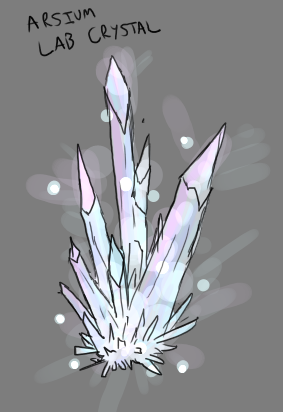Arsium (Ar-see-uhm)
Arsium is a stable transuranic element with 127 Protons and 218 Neutrons; with Arsium 345 being the only known stable isotope. The material can be synthesized in supercolliders or mined from the remnants of supermassive stars, as well as collected from Kur pearls and the remnants of other Xarian technology. It has extremely low abundance in the universe; so low that many civilizations may not even discover that it exists at all. Even the most efficient modern synthesis methods are incredibly energy and resource intensive for the amount of material created. Because of this Arsium tends to be use as a stabilizing agent in small quantities to boost the properties of other alloys; with correctly made Arsium-doped alloys typically having superior properties to their mundane counterparts.
Though the material exhibits a number of anomalous properties, indicating that the baryons within the nuclei may decay into something more exotic. It has incredibly high material strength; forming extremely strong atomic bonds. Density an order of magnitude higher than any known element; at around 300 grams per cubic centimeter. How these properties are achieved is unknown.
Many artifacts, including the corpses of various Xarian forms have been discovered to have further anomalous properties. This would seem to indicate that Arsium can conduct psionic or intrinsic energies to create technologies that are utterly unknown to the dominion.
Properties
Material Characteristics
Arsium, in its pure form is a silvery metal with an iridescent quality to it. Depending upon the "grain" of the crystal structure it may appear slightly turquoise, blue, or violet in color. The metal is very hard and mildly brittle. When under significant stress it does not often bend very much but rather simply cracks or breaks. It is possible to make wires or foils from the metal though placing these under too much stress can result in failure.
Physical & Chemical Properties
Super cross-sectionality
Arsium exhibits a property known as super cross-sectionality meaning that whenever a particle passes through it, it will be forced to interact with the material. This makes the material excellent radiation shielding as high energy gamma rays or other forms of radiation that might require many centimeters of material to block can instead be avoided by a thin foil of arsium. Similarly this property makes it interact with neutrinos, tachyons and pions, allowing effective absorbers of exotic particles to be created. In theory this could be used to not only harden spacecraft against cosmic rays but also some types of exotic or phasic weapons. For instance pion weapons, which could decay inside of a ship and delicate internal components would be forced to interact with the hull instead, if a thin arsium layer were installed in the hull. Though this interaction with the weapon would still impart energy into the armor, and therefore damage it.Extreme chemical resistance
Arsium behaves similarly to a noble metal such as gold or platinum, being very resistant to chemical attack by way of acid or oxidation.Geology & Geography
Arsium can be found virtually anywhere (asteroids, trace amounts in stars, small planetary bodies). However it is most commonly found in the cores of large planets. Due to its high density and melting point large deposits of solid crystals may accumulate deep within a planets core or dissolved into the mantle. Mantle mining methods can be used to extract industrial quantities.
Origin & Source
Arsium is typically created by the deaths of supermassive stars or the collisions between neutron or quark stars. It can be synthesized by smashing lighter elements together though this takes immense amounts of energy and mining the material is often vastly more practical.
127A
345
Type
Metal
Value
High
Rarity
High
Odor
None
Taste
None
Color
Iridescent Silver
Boiling / Condensation Point
28,585k
Melting / Freezing Point
15,272k
Density
~300g/cm^3
Common State
Solid
Related Species
Related Items
Related Technologies





Comments